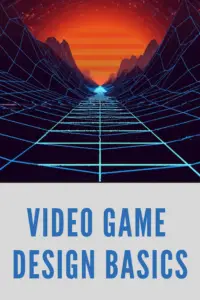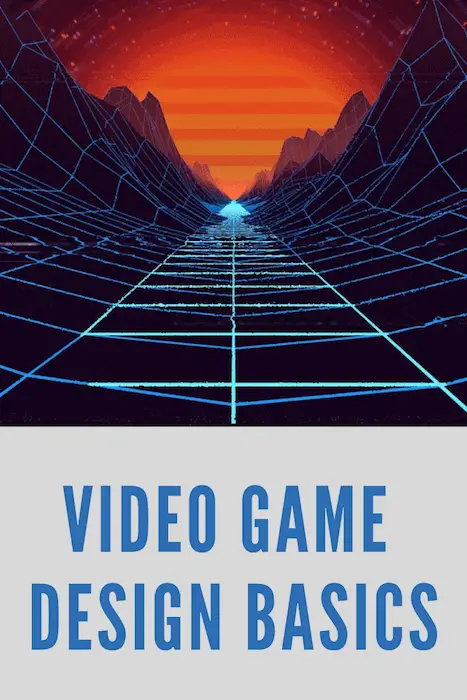Designing a video game can be fun, but it also involves countless hours of work. Video game designers must be mindful of a multitude of areas in order to do their jobs successfully, so I put together this video game design basics guide to help.
So, what are the basics of video game design? They are:
- Great Gameplay Mechanics
- Rewards for the Players
- A Unique Story
- Relatable Characters
- An Environment that Serves the Gameplay and Story
Let’s examine each of these areas in more detail so you can apply them to your game design.
Great Gameplay Mechanics
Gameplay mechanics are the rules and systems that determine how your character will be able to interact with the world around them. The majority of a player’s time will be spent using the gameplay mechanics they’ve been given to accomplish the tasks that have been set forth by the game designer. Because of this, your gameplay mechanics should be one of the first things you determine.
Here are a few examples of gameplay mechanics from popular games:
-
- Flappy Bird – Avoid obstacles for as long as possible.
- Mario Kart – Driving and using abilities.
- Shadow of the Colossus – Climbing, exploration, and combat.
- Super Smash Brothers – Knocking players off of a platform.
- Rime – Solving puzzles to advance the storyline.
Games can have as many or as few gameplay mechanics as the game designer desires. However, the more complex and numerous the gameplay mechanics are, the more likely a player is to become confused and frustrated while playing. Because of this, it’s imperative that games take time to teach players how to use the mechanics they’ve been given.
Teaching Players the Gameplay Mechanics
There are three primary ways to educate your player about the gameplay mechanics.
1 – Provide a Written Explanation.
My least favorite method for teaching a player gameplay mechanics is by means of a written explanation. No one (for the most part) wants to read pages of text before they’re able to jump into the action of a game.
Written explanations are an attractive option for game designers because they can be created and implemented quickly. However, they often detract from the experience of the player and run the risk of driving players away altogether that don’t have the patience to read them.
2 – Provide a Visual Demonstration.
The next option for educating a player about gameplay mechanics is by giving them a visual demonstration. Some examples of this would be a cutscene with a voice-over explaining the mechanics, or a cut scene of a non-playable character demonstrating the mechanics.
While certainly a step up from the experience of reading about the mechanics, visual demonstrations still place players in the passenger seat, rather than creating an engaging experience for them.
3 – Provide a Hands-on Experience.
Last but not least is teaching players by means of hands-on experience. The perfect example of a game that does this is The Legend of Zelda: Breath of the Wild.
This game is jam-packed with gameplay mechanics, has little to no written tutorials for the player, and yet the experience never feels overwhelming.
How did the game designers achieve this? By letting the players use the mechanics in cleverly disguised tutorial levels known as Shrines. In the midst of an open-world game where you can go almost anywhere, these Shrines present clear challenges to players that force them to experiment with the tools they’ve been given.
As you progress throughout the Shrines, you gradually learn new techniques for the tools in your arsenal that you can then utilize throughout the rest of the game.
Game Mechanic Mistakes to Avoid
The primary mistakes to avoid concerning gameplay mechanics are:
Mistake 1 – Creating gameplay mechanics that are too complex for your players.
Mistake 2 – Creating gameplay mechanics that feel repetitive.
Mistake 3 – Creating gameplay mechanics that don’t present enough challenge for players.
Mistake 4 – Creating gameplay mechanics that aren’t fun.
Mistake 5 – Creating inconsistent gameplay mechanics that can’t be built upon.
Gameplay mechanics can make or break a video game, so it’s worth the time and effort to tweak the mechanics until they feel just right.
In-Game Rewards for Players
What keeps a player engaged with a video game? A rewarding experience. The reward system in a game is what compels a player to continue playing. Here are a few common reward systems that can be used to motivate a player:
1 – Story.
One of the most powerful motivators for playing a game can be a good story. If the story for a game is interesting and leaves players with burning questions that can only be answered by getting to the end of the game, then they are very likely to continue playing.
2 – Collectibles.
Collectibles are frequently used by game designers to maintain a player’s interest between the more poignant moments of a game. Collectibles might consist of new outfits, in-game currency, letters that expand the story, artwork, songs, or interesting objects that relate to the player.
Two great examples of games that successfully use collectibles are the puzzle platformer, Rime, and Spider-man PS4.
3 – Abilities.
Incrementally giving a player new abilities throughout a game is a popular tactic used by game designers to keep the experience from becoming boring.
You can give new abilities to your players by making them gather a certain amount of experience points or in-game currency, or by making it a part of the storyline.
4 – New Areas.
Games that have interesting environments can leverage this by making new areas accessible only by progressing further in the game.
5 – New Playable Characters
If a game has an interesting cast of characters, a great reward for players can be allowing them to unlock the ability to play as those characters. This can make a for a completely new gameplay experience if the unlocked characters have their own sets of abilities.
A Unique and Memorable Story
While you can certainly make a video game without a story, there are a number of compelling reasons to give your game a storyline.
The story in a video game is an opportunity for game designers to breathe life into the gameplay mechanics, environment, and characters, and make players care about what happens in the fictional world around them.
Tips for Writing a Video Game Story
1 – Determine Your Gameplay Mechanics First.
You don’t need to have every last intricate detail of your gameplay mechanics decided before you begin conceptualizing your story, but you should at least have a basic idea of the main abilities your player will have, and how those abilities will lend themselves to the gameplay.
If you plan on having a character with the ability to lift objects with their mind and teleport, then you should create a story that addresses those abilities and provides a suitable setting.
2 – Determine the Emotions You Want to Relay
One of the best ways to shape a video game story is by starting with an emotion in mind. A game that’s written with the emotion of fear in mind will need a story with plenty of tense situations. A game written with joy in mind will need a story that’s playful and humorous.
Take a look at the following list of emotions for ideas about the type of emotion you would like to communicate in your game:
-
- Happiness
- Sadness
- Fear
- Anger
- Disgust
- Surprise
- Awed
3 – Make a Video Game Story Outline
Poorly planned storylines can frustrate players and make them lose interest in a game. Because of this, it’s important you know where your story is going to go from the very beginning.
There are countless methods you can utilize for outlining your video game story, but here’s my favorite one.
Begin by writing out the major moments of your plot. Your main plot points might look like this:
- Character is given an ancient map.
- Character follows the map to a magical artifact that gives them powers.
- An evil force awakens and seeks after the artifact.
- Character must defeat the evil force with their new powers.
Once you have your main plot points planned out, the next step is to go back through your story and connect the points to one another with additional details. When you’re finished, you should have a fully outlined story.
Relatable and Interesting Characters
The main character in your video game plays a significant role in shaping the player’s experience. There are millions of ways to go about the characters in your game, but one of the most popular is a blank slate character.
A blank slate character’s storyline typically involves some type of incident that causes them to forget all of their memories. This allows players to learn everything just as the character learns them, without having to be told a huge backstory.
Another common trait in blank slate characters is that they might rarely speak. This encourages players to project themselves into the role of their character.
This type of character works best for games with generic themes, like good versus evil, rather than more intricate stories that focus on the character’s thoughts and emotions.
Here are a few examples of games that use blank slate characters:
If you don’t plan on using a blank slate character, a great way to get a well-rounded character is by examining the 16 Myers-Briggs personality types and placing them in one.
You can even take a Myers-Briggs personality test from the perspective of your character and see what you end up with.
It might not seem like much, but having a personality profile to reference as you’re developing your story can go a long way in creating a believable character.
An Environment that Suits Your Gameplay Mechanics and Story
The environment for your game must work hand in hand with the storyline and gameplay mechanics for your game. As you’re outlining your story, you should be deliberate about the environments you select because those environments will ultimately need to be turned into levels.
The ideal environment for your game will work naturally with the gameplay mechanics you’ve chosen and present interesting opportunities for players to use them.
If you’re struggling to come up with an interesting environment for your game, one of my favorite ways to get inspiration is by looking at concept art on websites like Pinterest and Reddit.
For more game design inspiration you can get back to all of my articles here.


